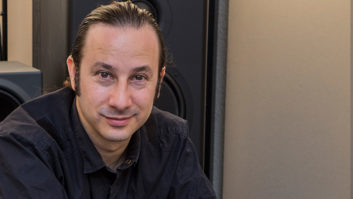Expanding on a January 2018 feature on Maor Appelbaum and his appropriately titled mastering facility, Maor Appelbaum Mastering, here’s additional conversation and insights that didn’t make the original article.
“I think that as long as I’m open to listening to other processing options and gear, I can learn from it,” says Appelbaum. There is so much equipment available, from the time since recording began to the present day, that it’s impossible to have experienced everything. “Somebody shows you something that you had never seen before, you say, wow, I’ve never heard that.”
It doesn’t mean that you can’t do records without the latest discovery, of course. But the good thing about exploring the world of available processing equipment is that you’re potentially opening yourself to a faster workflow as well as the possibility of getting that certain sound that you didn’t have before, he says. “And maybe that’s exactly what’s needed.”
When Appelbaum mastered Faith No More’s 2015 comeback album, Sol Invictus, for example, saturating the signal through his Rupert Neve Designs Portico II was enough to give him the high-mid bite he was looking for. “I used it just for the tone, for the edge. It excited it.”
When he bought the SPL Iron, while it offered all sorts of processing options, just putting it in the signal chain made a rounder sound. “It was an extreme metal band from England that had sent me a track,” he recalls. The mix was good, says Appelbaum, but he felt he could add something. “I engaged the AirBass function on it. It really worked well. I’m sure I could have done without it, but it rounded off the edges and added some lushness and fullness to it. I sent it to the band and they said, ‘We would like to hire you for the album.’ I guess it was the right thing to do.”
Sometimes, adding a new piece may even reduce the amount of processing needed further down the chain. “It’s like committing to a recording,” he says. “When you get the tone you want, you need less work on it later. I try as much as I can to fit most of that processing at the beginning, at least get to most of the vibe of it in the first stage, and then whatever is needed later I can always add or subtract.”
He offers a culinary analogy: “It’s like a recipe. You might still need to tweak the seasoning later, but if you put something in at the beginning, then the reduction/addition is a bit more calculated.”
When evaluating a new piece of equipment, he continues, “Usually I don’t try it on the projects I work on for my clients. I don’t want to like it and then have to buy it because I already used it on the song I tested it on. I’ll use it on something I already had worked on which I know very well and am already happy with the final outcome.”
Once purchased, it can take some time to find a place for a newly acquired piece, says Appelbaum. “I put it in the desk and let it be there for a bit. Then, slowly, I’ll turn it on, and give it time. You can turn it on in the beginning and get totally excited, but sometimes it’s not really THE thing; it’s just new, and that can alter your judgment.
“Or it’s the opposite: it just doesn’t fit the project and you’re disappointed. So it’s important for me to not get too excited with the fact that I just bought it and, instead, slowly learn where it fits, and insert it only when I feel it actually adds something good to the project, not because I just bought it.”
One way to ensure that a device performs exactly as needed is to work with the manufacturer on customization, as Appelbaum explains. His Overstayer M-A-S Model 8101MA is a custom modified version to the standard issue unit, hence the suffix, for Maor Appelbaum.
“We had altered it so much,” he says. “We changed the gains and added a crossover circuit, so I can saturate the lows or the highs, or both.” He worked with designer Jeff Turzo for about a year, choosing custom frequency settings, changing the functionality to include saturation balance control and doing extensive listening tests to confirm their choices down to the component level.
Appelbaum has several converter options for playback and capture. One choice is the JCF Audio Latte, which he has been using for years. “It’s smooth and full; you feel very close to the material,” he says.
His alternate selection for playback is Crane Song’s new HEDD Quantum, to which he upgraded from the previous version. “It’s tighter and clearer than the previous HEDD DA section. I used the Quantum on the Pigface album remastering. That helped with the stereo image, being very open and wide, while the SPL added sheen and a bit of glue.” For capture he will use either the Latte AD Section or a JCF AD-8.
On the monitoring side, he has another two D-to-A options. “The Benchmark DAC1, then I move to the Lynx Hilo when I want to compare songs on Pro Tools.”
The Hilo functions in a number of ways, he says. “One, it’s an interface from the computer, the DAW, to the desk, USB to AES. It’s important to have something that interfaces very well with the DAW, is very stable, easy to route and has metering and a bunch of outputs.” Clocking is provided by the new Antelope Audio 10MX and a few other options such as Mutec MC3+ and a Ref 10, he adds.
Various other pieces he owns are either close at hand or can be brought into the signal path, he continues, including a modified API 2500 and a 5500, a Neve 33609, an old SPL PQ 2050 mastering EQ with motorized knobs, an SPL Kultube compressor, Dave Hill Titan compressors, a Kush Audio UBK Fatso, A-Designs EM-EQ2, Manley Massive Passive EQ, Manley Vari-Mu compressor, Dangerous Bax EQ, Dangerous compressor, Maag EQ4M, InnerTube Audio Atomic Squeezebox, Maselec MEA2, Millennia Media NSEQ4 and much, much more. “And I’ve been a big fan of the Weiss gear for years,” he says.
The PMC IB1S main monitors are his usual choice, “I love using the PMC IB1S monitors and the Bryston 4B SST square power amp; it’s a great combination,” he says. “I also have Neumann KH310 three-way speakers, KRK V4-S4s and Reftones, so I can check how it translates on other speakers in case I feel that I need another perspective.”
Appelbaum has done numerous mastering projects for Billy Sherwood over the years, most recently working on a YES live double-album, Tales from Topographic Oceans and Drama. He worked on albums from Eric Gales, Robin Beck, Steelheart, Armored Saint, Hellhorse and Goatwhore, which got into Billboard’s Heatseeker chart, he reports. “I also remastered the first three albums of Today Is the Day’s catalogue,” he says.
For his lecture on mastering different types of music for the international market that he will present at the 2018 NAMM Show at the end of January, Appelbaum will discuss the differences between various styles and territories. “For example, years ago I worked with Rob Halford’s band Halford; I did two studio albums and a bunch of live albums and DVD/Blu-rays. He has an American crowd and a European crowd, so you want it to appeal to both crowds. You bring the tightness of the European stuff and the low end of the American stuff. It’s not easy to do, because low end will also affect how tight it is. But you can find a happy spot between them.”
Often, the project will suggest a certain treatment, so Appelbaum will open a dialog: “I will communicate with the producer and artist to understand what they are expecting and wanting, especially when there are different aesthetics involved.”
For example, he says, “I worked with an indie rock artist that had a nineties vibe and asked if he wanted me to go in that direction and he liked it very much. Another example; I just worked with a metal band from the Bay Area. They sound like early Metallica, so I asked if it is OK to go in that direction and they loved the idea, so I made it sound more like that. Every project has its own custom sound and I tailor it to fit with the artist’s vision of the sonic signature and music.”
But ultimately, he says, “What’s important for me as a mastering engineer is making the audience feel like everything was intentional. When it’s convincing, people connect to it.”





